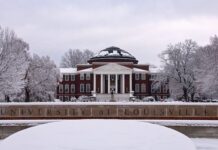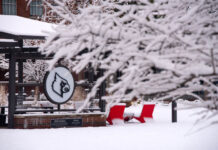History is not only found in books. Trees also play silent witness to events beneath their branches. Imagine the stories the trees on the University of Louisville’s Belknap Campus might tell if they could speak.
A white oak behind Grawemeyer Hall is thought to be the oldest on campus — a survivor of a wooded, 40-acre campus that was the site of a Louisville and Jefferson County Children’s Home in the late 1800s. What stories might it tell of the college students it has seen since 1925 or the delinquent and truant children who once played beneath its branches.
Some of my earliest memories involve trees. Climbing the old peach tree in the front yard to pick its bounty of fruit was a seasonal treat. I still have the scar from slipping off the log that spanned the creek in the woods where my brother and I spent days of adventure. So it was a pleasant surprise when I drove from St. Louis to interview for a job opening at UofL to see stands of trees on what I thought would be campus of concrete.
You see, the oak is not alone and helps form a substantial arbor of more than 1,000 trees that make the Belknap Campus more park-like than many of its urban peers in higher education — certainly more than the one I left years ago in St. Louis.
Over the last few months, I have been involved in two projects to help tell the stories of UofL’s trees.
One project — a self-guided tree tour — is designed to invite faculty, staff, alumni, students and the public to enjoy and learn from the diversity of trees on campus. The guide — both printed and online — will showcase many interesting specimens such as the old oak. The tour is part of a “Destination UofL” initiative that encourages campus visits.
“Our surveys have shown a marked change in perspective after first-time visitors see the campus,” said John Drees, director of communications for Belknap Campus. “Our green spaces and beautification of Belknap Campus enhance our image and help us in recruiting students and faculty to UofL.”
Justin Mog, assistant to the provost for sustainability, sees more.
“Our trees are a vital part of campus environment,” Mog said. “They affect almost all aspects of our goals related to climate action and energy use.”
Mog sees the tour as part of another initiative to gain a “Tree Campus USA” status for UofL. That’s the second project in development. This distinction from the national Arbor Day Foundation requires an active campus plan to preserve and maintain the arbor. UofL met or exceeded all the requirements for this designation in 2010.
Mog formed a faculty, staff and student committee that prepared UofL’s application to the foundation and a strategic plan for managing UofL’s trees. The application was submitted to the foundation in December, and UofL should be informed of its status this spring. The group also will recommend a tagging system to identify trees and other interesting specimens on the tour.
“Green can be gold. A commitment to trees on our campus reduces the amount of energy consumed to cool our buildings as well as carbon dioxide in the atmosphere,” Mog said. “Green spaces and urban forests benefit our environment while adding the value of an attractive campus.”
A printed tree tour guide will be available in April at the UofL welcome centers, and an online version is planned.

























